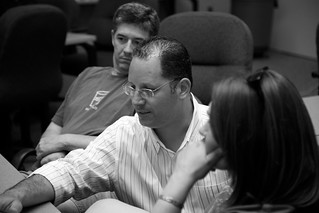PLE Symposium - What I meant to say ...
1/28/2007 03:12:00 pmIn some ways it was like a small scale Manitoba edublogger meet up. I finally shook hands with Clarence Fisher and George Seimens. John Evans was there too. John and I have been trying to share a cup of coffee for a while now; it was good to chat and catch up with each other a bit. I also had the pleasure of meeting Karen Phillips and Joan Badger who teach at an elementary school here in Winnipeg.
I had brought along my AP Calculus class. Three of them participated in a panel discussion exploring how high school students learn with and use technology in their lives at home and at school. As the discussion progressed several of the students in the audience also spoke up and shared their perspectives ... I'm very proud of them. Several people approached them just before lunch to say how impressive they all were. Of course, I think they're right, but I guess I'm biased. ;-)
Clarence, George and I had been planning for this event for a few months. Clarence and I got to spend some quality time at Starbucks between the end of the symposium and joining George, Peter Tittenberger and Terry Anderson for dinner. The staff at the University of Manitoba Learning Technologies Centre were warm, welcoming and gracious. Everything went beautifully until about 20 minutes before we started our presentation. While there was an internet connection for the live webcast there was none for us as presenters. This didn't really impact George or Clarence, whose presentations didn't require internet access. All my materials were housed on a wiki and I had planned to showcase some of my online teaching strategies using examples of student work and some video content.
So there I was. A little shell shocked and not really listening to what George and then Clarence were saying as I scrambled to figure out how I was going to finesse this. I decided to tell some stories. The webcast was recorded and I'll link to it here when it's published; probably within the next week or so. I may have stirred the pot a bit with some comments I made during the Q&A session following our talk. ;-)
Anyway, this being the the read/write web I decided to publish my presentation the way I had planned it here. Since I'm presenting solo this time I've also given myself leave to wave the 15-20 minute time limit. In the end I'm not entirely happy with the way it came out ... I think I ramble a little too much and the lack of a live audience affects the way I speak. I think my voice is more "energetic" when I speak live. ;-)
There are two ways you can view the presentation (after all, it's all about giving the learner control; isn't it?):
(1) Watch the screencast. (60 Mb, 42 minutes 14seconds)
(2) Listen to the audio (20.3 Mb, 42 minutes 14seconds) and click through the links in the presentation below. I've copied the original from my page of the wiki we had used to collaborate.
Hi. I'm Darren.

My Professional Blog: A Difference.
Thinking About Innovation in Education ...
During revolutions, scientists see new and different things when looking with familiar instruments in places they have looked before. (Kuhn, 1969)
What can I do now that I couldn't do before?
• Links, tags, RSS
• Replicable, Scalable, Sustainable
• Examples: Flat Classroom Project, Room 208 209, Mark Ahlness and the Mighty Writers
My Pedagogical Improvisation ...
My Guitar
First A Demo ...
Pre-Cal 30S (Fall '06) (Grade 11)
Pre-Cal 40S (Fall '06) (Grade 12)
AP Calculus (2006-07) (Grade 12)
My Favourite Riff
Scribe Posts
Learn about Scribe Posts then visit The Scribe Post Hall Of Fame.
Jamming
Evolving the practice ...
• Chat Boxes
• Feed Windows
• New technologies give rise to new pedagogies ... pictures worth more than 1000 words.
• Give students the tools ... then watch what they do.
• Developing "expert voices."
Ambiance
The object of learning is changing ...
On the first day of class this year I saw all my classes for only 30 minutes each. That was the day my daughter Emilia started grade one. I showed them this video ... a remix I made of the original made by Karl Fisch. (This is the first in Karl's trilogy on the changing nature of education; part 2 is called What If and part 3 is called 2020 Vision.)
Have you read Thomas Kuhn?
A Message from Karl Fisch.
If you're thinking seriously about pedagogy ...
Robert Marzano (A Handbook for Classroom Instruction That Works (2005); quick summary of main ideas)
How People Learn (1999)
If you're interested in other people's reflections I've come across two blog posts summarizing the symposium. One by Carol Thomas and another by The Illuminated Dragon.



1 comments
Once again, a masterful analogy and description of your work. I'll be using it for sure!
ReplyDelete